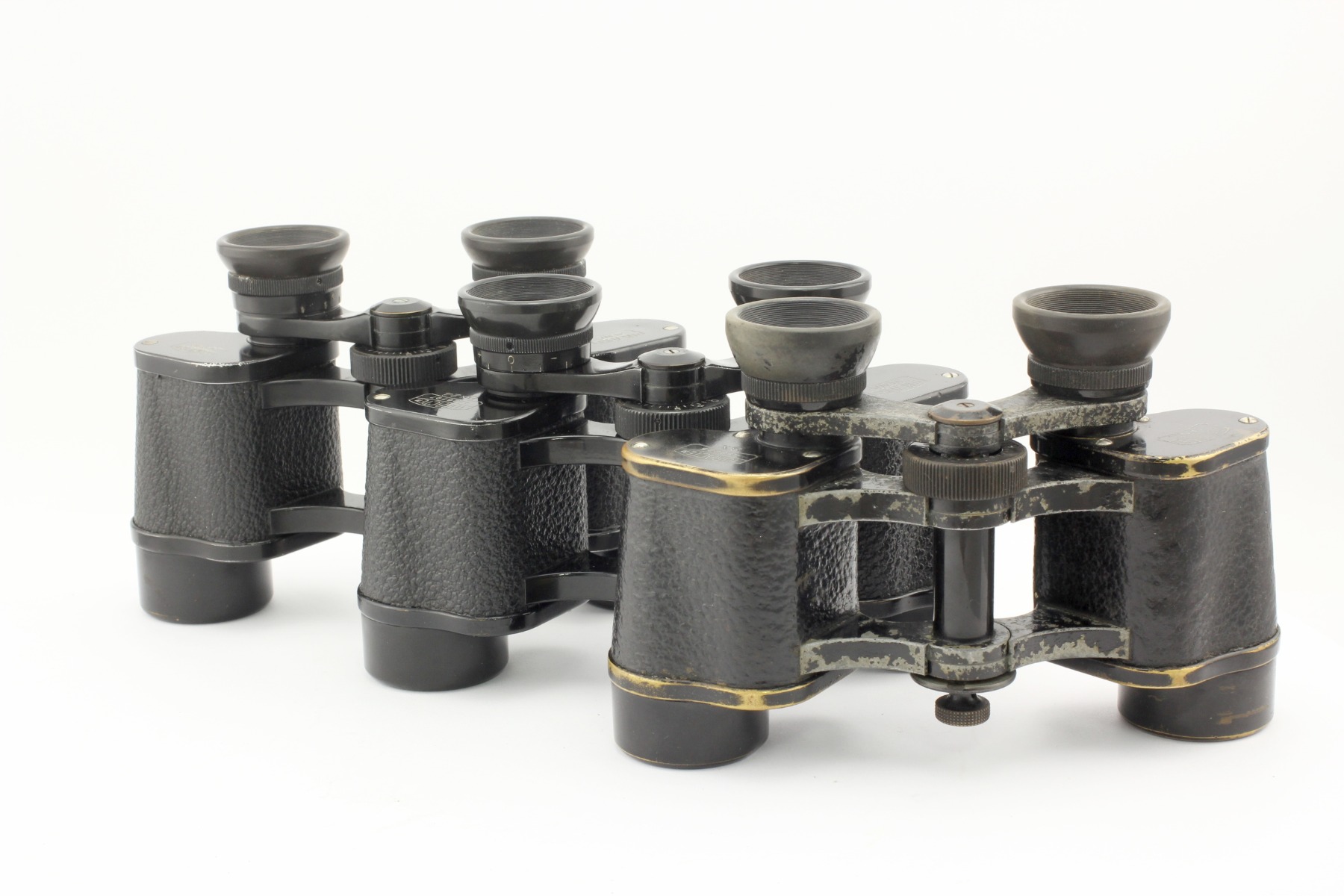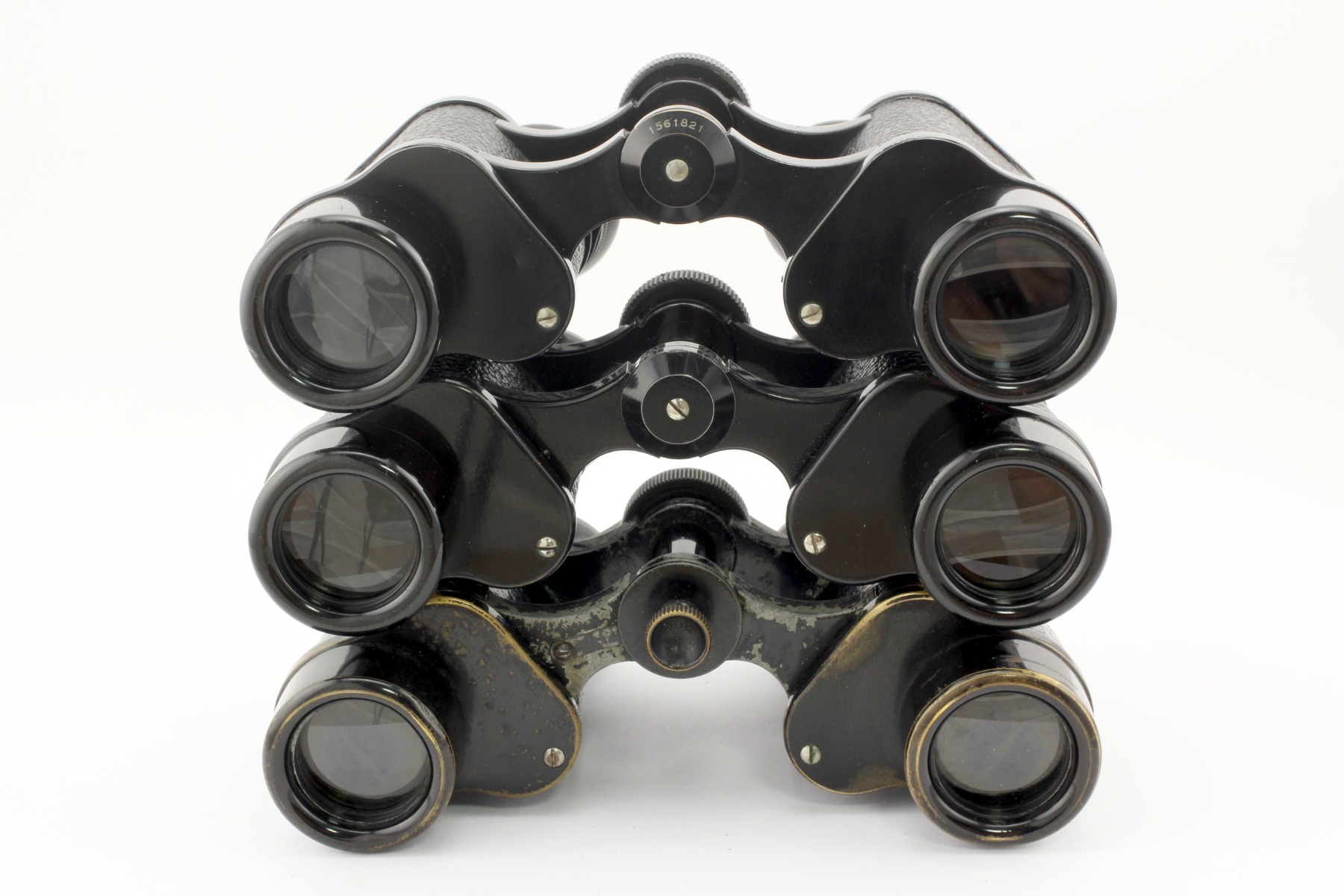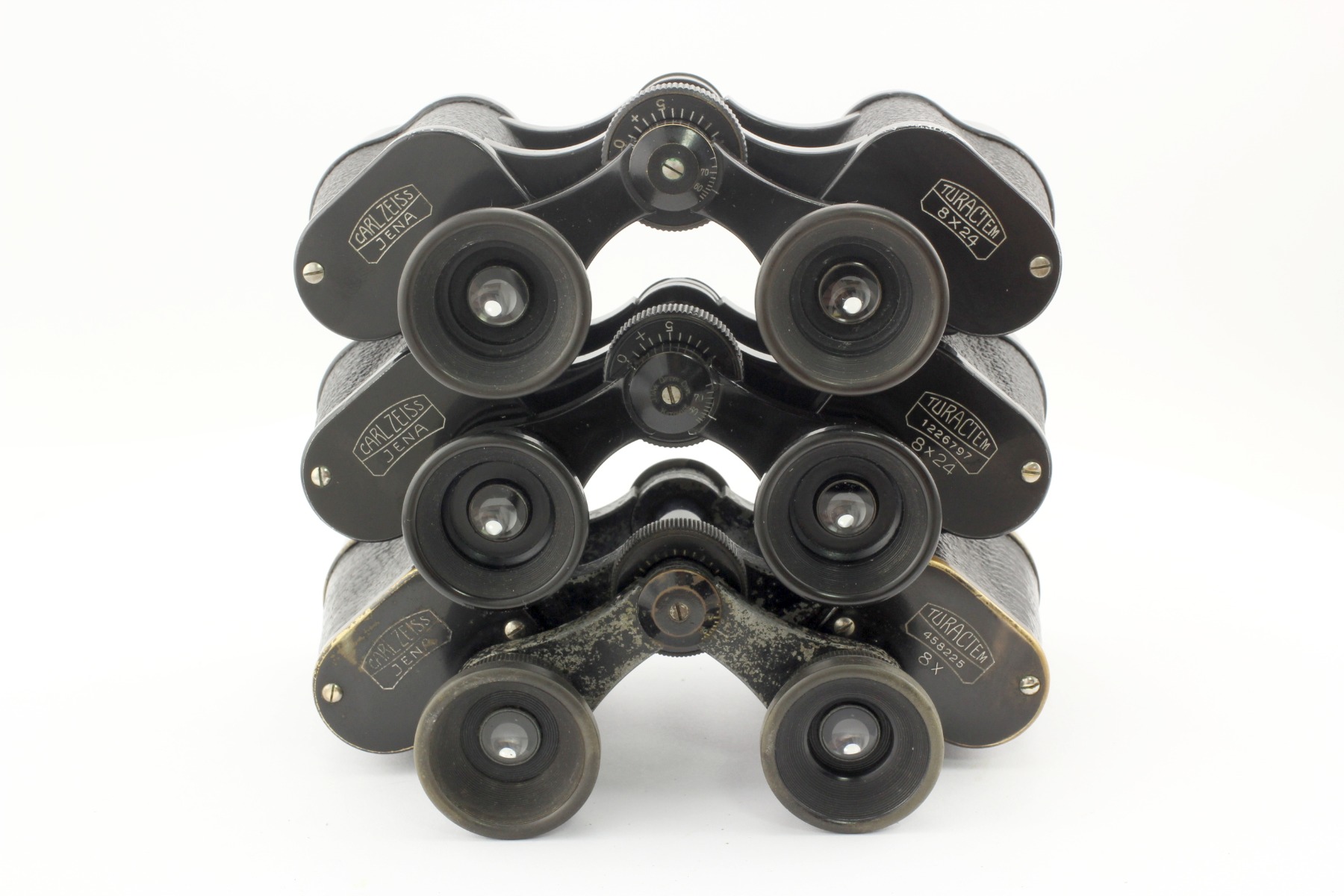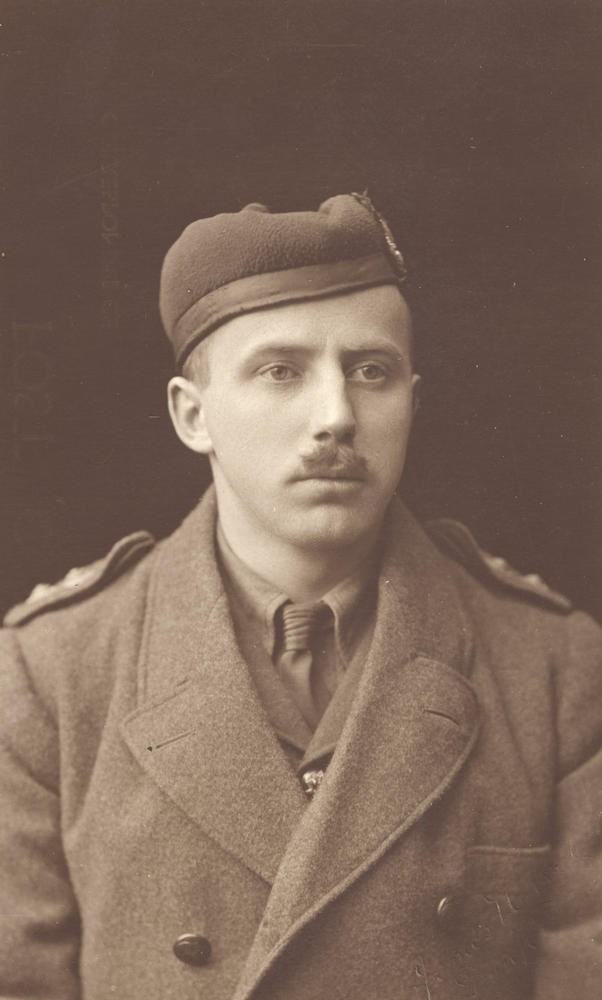Magnification: 8x
Aperture (objective diameter): 24 mm
Field of view: 6.3°
Exit pupil diameter: 3 mm
Visible field of view (eyepiece FOV): 50°
The closest focusing distance: 15 m
Width: 14.5 cm
Height: 9.5 cm
Weight: 495 g
Production date: 1912-13.
Binoculars Carl Zeiss Jena Turactem 8x
The binocular model with central focusing, namely Turactem 8x, appeared in Zeiss catalog T180 in 1914. The device replaced rather successful Telactem 8x model: Zeiss decided to make a cheaper binocular, so he simplified the Turactem design. The new device turned out to be much smaller and lighter, and respectively, more convenient to use. However, its field of view decreased (from 6.6° to 6.3°) and aberrations increased.



However, earlier, in 1912, a very rare and little-known Turactem 8x model, which did not appear in any catalog, was released: the mentioned device had not central, but lateral focusing. French theatric binoculars of the 1830s served as the prototypes for such rare focusing type. Their operation principle is simple: the right eyepiece ring rotation on the thread was transmitted through the eyepiece bridge to the left eyepiece, which had a separate diopter sharpness adjustment. The latter moved inside hollow hinge axis with the help of the rod to provide bridge rigidity (see photo and video).
However, earlier, in 1912, a very rare and little-known Turactem 8x model, which did not appear in any catalog, was released: the mentioned device had not central, but lateral focusing. French theatric binoculars of the 1830s served as the prototypes for such rare focusing type. Their operation principle is simple: the right eyepiece ring rotation on the thread was transmitted through the eyepiece bridge to the left eyepiece, which had a separate diopter sharpness adjustment. The latter moved inside hollow hinge axis with the help of the rod to provide bridge rigidity (see photo and video).
The central focusing flywheel is completely absent. This operation principle often led to the left eyepiece pinching, the structure rigidity was insufficient. Because of this, the binocular often had misalignment (lack of the optical axes parallelism); moreover, its production was complicated and expensive. Therefore, at the end of 1913 the "experiment" was completed and the design was considered to be unsuccessful. Only several hundred pieces of these binoculars were produced in total. In addition to Turactem 8x model, Telefortem 12x and Trentactem 8x binoculars were produced with this type of focusing for a short time.
Turactem is a “civilian” model, this fact is proved by the focusing principle and the central hinge fixture’s (clamp’s) small diameter (see photo), which has a hole for a knob (included to binoculars delivery kit), with the help of which the hinge could have been finally fixed depending on the observer’s interpupillary distance. The interpupillary distances scale is indicated on the upper hinge disk.
The considered device’s base diameter of the eyepieces is equal to 20.5 mm and the upper prism cover width is equal to 46 mm (see photo). The eyepieces’ front lens diameter is 10.5 mm. The eyepieces have a diopter scale and the diagonal knurling. The binocular’s body height (including upper prism cover) is equal to 68.5 mm; the height without lens frame is 52 mm. It is noteworthy that prism covers do not have fastening screws for attaching them to binocular’s body.
There are inscriptions “Carl Zeiss Jena” on the left prism cover. There is also an inscription “Turactem 332082 8x” on the right prism cover. The inscription is encrusted with the help of silver alloy and is made in block letters against the background of Carl Zeiss Tessar photo lens schematic image.
The binocular’s coffer is also very interesting: it has features peculiar to both – Zeiss coffers of that period (the spring-design of the top cover fastener) and "English" elements (no rivets, the way the top cover is attached to coffer’s body).
In addition, there is an inscription on the coffer’s top cover: “CAPT WELLER H.I.L.” and "7TH" (poorly readable). According to the words of this binocular former owner, this civilian device belonged to an English serviceman, captain George Herbert Weller, who served in the 7th Highland Light Infantry during World War I (see inscriptions on coffer cover) and who died heroically in battles on Gallipoli Peninsula (Turkey) in July 1915.
Turactem is a “civilian” model, this fact is proved by the focusing principle and the central hinge fixture’s (clamp’s) small diameter (see photo), which has a hole for a knob (included to binoculars delivery kit), with the help of which the hinge could have been finally fixed depending on the observer’s interpupillary distance. The interpupillary distances scale is indicated on the upper hinge disk.
The considered device’s base diameter of the eyepieces is equal to 20.5 mm and the upper prism cover width is equal to 46 mm (see photo). The eyepieces’ front lens diameter is 10.5 mm. The eyepieces have a diopter scale and the diagonal knurling. The binocular’s body height (including upper prism cover) is equal to 68.5 mm; the height without lens frame is 52 mm. It is noteworthy that prism covers do not have fastening screws for attaching them to binocular’s body.
There are inscriptions “Carl Zeiss Jena” on the left prism cover. There is also an inscription “Turactem 332082 8x” on the right prism cover. The inscription is encrusted with the help of silver alloy and is made in block letters against the background of Carl Zeiss Tessar photo lens schematic image.
The binocular’s coffer is also very interesting: it has features peculiar to both – Zeiss coffers of that period (the spring-design of the top cover fastener) and "English" elements (no rivets, the way the top cover is attached to coffer’s body).
In addition, there is an inscription on the coffer’s top cover: “CAPT WELLER H.I.L.” and "7TH" (poorly readable). According to the words of this binocular former owner, this civilian device belonged to an English serviceman, captain George Herbert Weller, who served in the 7th Highland Light Infantry during World War I (see inscriptions on coffer cover) and who died heroically in battles on Gallipoli Peninsula (Turkey) in July 1915.

More information is available by the following link: https://universitystory.gla.ac.uk/ww1-biography/?id=2933
The binocular’s serial number is "332082" and it was supposedly produced in 1912-1913.
Not taking into account the first, rare version of this model, with central focusing, Turactem was produced with minor design changes from 1914 until about 1932.
The Turactem’s “predecessor”, namely Telactem 8x model is available by the following link: https://binocollection.com/catalog/binoculars-carl-zeiss-jena-telactem-8x.html
The Turact 8x model with separate focusing can be checked here: https://binocollection.com/catalog/binoculars-carl-zeiss-jena-turact-8x.html
The binocular model with central focusing, namely Turactem 8x was released in 1914.
The binocular’s serial number is "332082" and it was supposedly produced in 1912-1913.
Not taking into account the first, rare version of this model, with central focusing, Turactem was produced with minor design changes from 1914 until about 1932.
The Turactem’s “predecessor”, namely Telactem 8x model is available by the following link: https://binocollection.com/catalog/binoculars-carl-zeiss-jena-telactem-8x.html
The Turact 8x model with separate focusing can be checked here: https://binocollection.com/catalog/binoculars-carl-zeiss-jena-turact-8x.html
The binocular model with central focusing, namely Turactem 8x was released in 1914.
